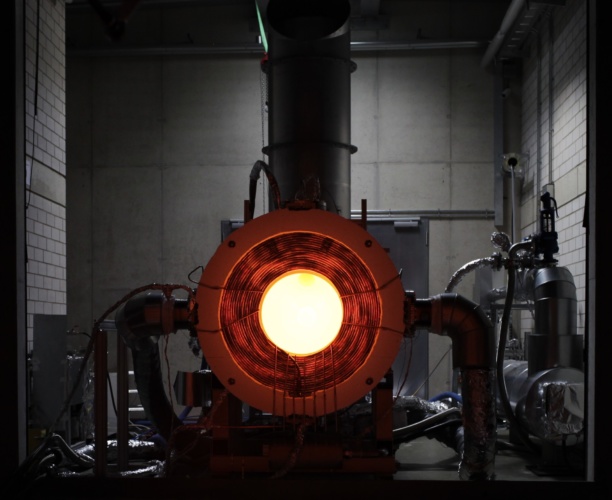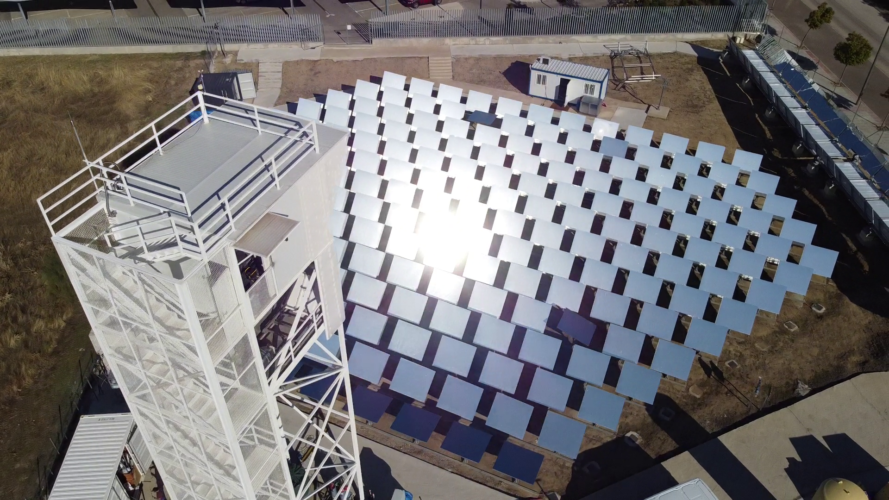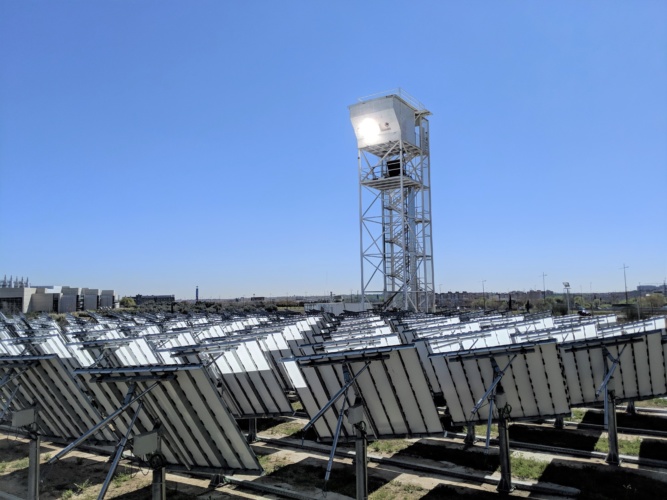
Concentrated solar energy has come a long way since the days of Archimedes. According to legend, the Greek polymath defended his home city of Syracuse from Roman soldiers using giant mirrors to focus the rays of the Sun, setting the invading ships on fire. It’s a myth that has captured the imagination for centuries, celestial power harnessed by one of the great geniuses of antiquity to repel an attacking army.
Today, solar technology has advanced to a point where we now use it to power our civilisation rather than torch our enemies. Concentrated solar power (CSP) – where moving mirrors called heliostats track the movement of the Sun to focus its energy in a solar tower – is more expensive and much less common than its photovoltaic (PV) cousin. However, it does bring certain advantages, one of which is that the intense heat produced can be stored or used for processes other than electricity generation.
This is where Synhelion comes in. Spun out from ETH Zurich in 2016, the Swiss startup is harnessing CSP to create synthetic fuels, using the extreme temperatures to essentially reverse combustion. If the technology can successfully be commercialised, it could play a major role in helping energy-intensive transport such as aviation and shipping decarbonise over the coming decades, replacing petroleum fuels with synthetic analogues that can literally be pulled straight from thin air.
“When you burn a fuel, you basically have the production of heat and water and carbon dioxide,” Dr Gianluca Ambrosetti, co-founder and CEO of Synhelion, explained to The Engineer. “Basically, what we do is look at processes that reverse that, and the most straightforward way is to take CO2, water vapour and use heat to try and reverse that process.”
A fundamental breakthrough for Synhelion has been the development of a new type of solar receiver that mimics Earth’s greenhouse effect to facilitate ultra-high temperatures. Concentrated rays from the heliostats enter the cavity of the receiver through a window at the front. The internal black surface of the cavity then absorbs the heat and reradiates it back into the cavity, where the greenhouse gas – usually a mixture of water vapour and CO2 - absorbs the thermal radiation and acts as a heat transfer fluid (HTF). According to Synhelion, the receiver can generate temperatures in excess of 1500°C.
“It is for sure one of the key elements,” said Ambrosetti. “Many processes need this temperature to become viable, to become feasible. And these high temperatures that can be achieved with our technology is really a necessary step to get to the thermochemical processes that we use for the production of fuels.”
The heat collected by the solar receiver is fed into Synhelion’s reactors, barrel-shaped chambers with bundles of tubes running through the centre. Depending on the process, the tubes are fed with different reactive materials. For ‘solar upgrading’, methane, water and CO2 can be converted to syngas at 800-1300°C. For fully carbon neutral synthetic fuels, water and CO2 alone can be converted to syngas via a two-step thermochemical cycle at temperatures up to 1500°C.
As solar upgrading is the more straightforward process, it is this that Synhelion will offer initially, producing synthetic fuels with a vastly reduced carbon footprint than petroleum-based equivalents, but nonetheless still polluting. As the technology evolves and the push towards net zero gathers pace, the company says it will be possible to retrofit its plants to generate carbon neutral fuels simply using water, ambient CO2 and heat.

While any type of fuel can be produced from the base syngas product, kerosene – jet fuel - will be Synhelion’s primary focus to begin with. The aerospace industry is under increasing pressure to lower its carbon footprint, but the energy density required for anything other than the shortest of flights means that sustainable aviation fuels (SAF) look the likeliest route to greener skies. Synhelion already has partnerships in place with Lufthansa and Zurich Airport to help put its technology in the mix.
“Aviation is in some ways the poster child, because it is obvious electrification will not make it any time soon,” said Ambrosetti. “Shipping and ocean freighters are also potential markets, but right now, we are focusing a lot on aviation.”
Obviously, geography plays an important role in deciding where to locate CSP. Sunnier climes with predictably cloudless skies are the order of the day, making deserts ideal. Not only does this terrain offer the hot and clear conditions required for maximising output, deserts are also by definition non-arable, where land-use is limited and crops cannot be grown.
To shed some light on just how important site location is, Central Europe receives approximately 1,200 kWh/m2 per year of direct normal irradiation (DNI) from the Sun. Synhelion estimates that for efficient production, sites need to receive around 1,800 kWh/m2, meaning only the very southern edges of Europe would be worth considering commercially. In the deserts of North Africa, the Middle East and the southwestern US, DNI figures rise well above 2,000 kWh/m2, making them prime territory for CSP.
“In the best locations in the world, in Chile’s Atacama Desert, you have 3,700 (kWh/m2),” said Ambrosetti. “This means that if I go to the Atacama Desert, I produce three times as much (as Central Europe) with the same plant and the same investment.
“And an important aspect of liquid fuels is that they’re easy to transport. So you don’t need to be so close to the user…we transport them now already across the world with minimal impact.”
A final, crucial part of the puzzle for Synhelion is Thermal Energy Storage (TES), high temperature chambers that essentially act as heat batteries for CSP, allowing production of fuels around the clock. Excess heat from the solar receiver flows to storage chambers via the heat transfer fluid, with the HTF then carrying that energy back to the reactor during cloudy periods or throughout the night.

“It’s a central part of our technology,” said Ambrosetti. “It allows continuous production, which is very important for most industrial processes. It’s about finding materials that are suitable, that have the stability, the performance, and last but not least, the cost. Because we need these materials in bulk volume.”
To that end, Synhelion is working with the Swiss federal materials lab Empa to identify and develop high temperature ceramics for the company’s TES solution, which is set to feature in an industrial demonstrator plant to be built in Germany in 2022. The next major step will be a commercial plant in Spain - ten times the size of the demonstrator - due to be operational by 2024.
By the end of the decade, it’s conceivable that solar fuels could be playing a pivotal role in the aviation industry, and potentially far beyond. Alternatively - if we’re still burning fossil fuels at the same rate we do today - as the great Archimedes himself may have put it, we’re screwed.
https://www.theengineer.co.uk/heliogen-the-bill-gates-backed-startup-hoping-to-use-mirrors-to-power-heavy-industry/




Nanogenerator consumes CO2 to generate electricity
Whoopee, they've solved how to keep a light on but not a lot else.